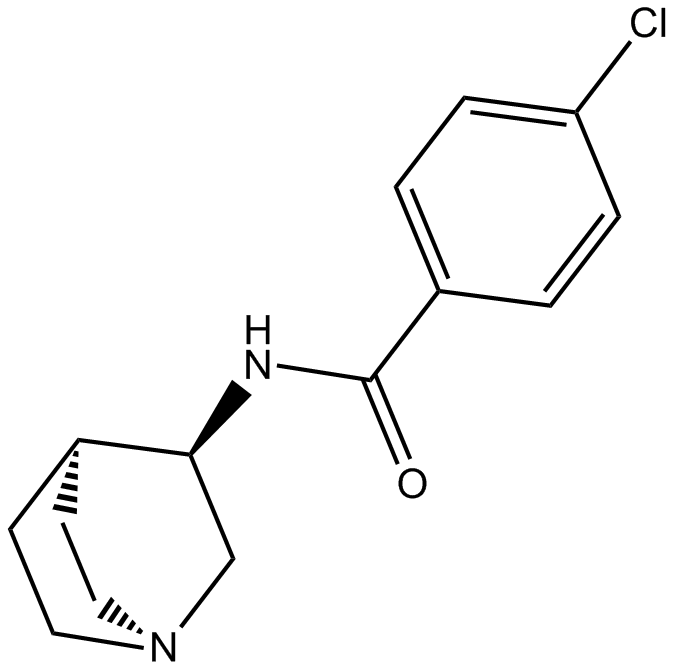PNU 282987 |
| Catalog No.GC12952 |
α7 nAChR agonist
Products are for research use only. Not for human use. We do not sell to patients.

Cas No.: 123464-89-1
Sample solution is provided at 25 µL, 10mM.
PNU-282987 is a selective α7 nicotinic acetylcholine receptor(α7 nAChR) agonist with Ki of 26 nM; no affinity for α1β1γδ and α3β4 nAChRs (IC50 ≥ 60 μM).IC50 value: 26 nM(Ki) [1]Target: α7 nAChR agonistin vitro: Treatment with PNU-282987 resulted in an attenuation of neuroinflammation in the MPTP-lesioned SN. Furthermore, PNU-282987 attenuated MPTP-induced dopaminergic cell loss in the SN and reduced striatal dopamine depletion [3].in vivo: Mice were subjected to 70% partial hepatic I/R for 60 min and pretreated with either vehicle or with PNU-282987, and blood and hepatic tissue samples were collected at 3, 6, and 12 h following reperfusion. pretreatment with PNU-282987 decreased serum transaminase levels and ameliorated liver injury after hepatic I/R. Moreover, pretreatment with PNU-282987 suppressed NF-κB activation, cytokine production (tumor necrosis factor α, interleukin 1β), and HMGB1 expression in liver after hepatic I/R [2]. Mice treated with 2.5 and 10 mg/kg of PNU devoted less time to rearing into open arms. In the HB task, MC mice displayed higher exploratory activity reflected in more head-dips (HD) during the first minute than EE and SE, whereas EE displayed low exploration levels reflected in total HD (5 min) [4].
References:
[1]. Bodnar AL, et al. Discovery and structure-activity relationship of quinuclidine benzamides as agonists of alpha7 nicotinic acetylcholine receptors. J Med Chem. 2005 Feb 24;48(4):905-8.
[2]. Dong Jun Yu, et al. Effect of ischemic preconditioning combined with α7 nAchR agonists on limb ischemia-reperfusion lung injury in rat. Biomed Res. 2017; Special Issue: ISSN 0970.
[3]. Li F, et al. The protective effect of PNU-282987, a selective α7 nicotinic acetylcholine receptor agonist, on the hepatic ischemia-reperfusion injury is associated with the inhibition of high-mobility group box 1 protein expression and nuclear factor κB activation in mice. Shock. 2013 Feb;39(2):197-203.
[4]. Stuckenholz V, et al. The α7 nAChR agonist PNU-282987 reduces inflammation and MPTP-induced nigral dopaminergic cell loss in mice. J Parkinsons Dis. 2013;3(2):161-72.
[5]. Mesa-Gresa P, et al. Behavioral effects of different enriched environments in mice treated with the cholinergic agonist PNU-282987. Behav Processes. 2014 Mar;103:117-24.
Average Rating: 5 (Based on Reviews and 25 reference(s) in Google Scholar.)
GLPBIO products are for RESEARCH USE ONLY. Please make sure your review or question is research based.
Required fields are marked with *




















